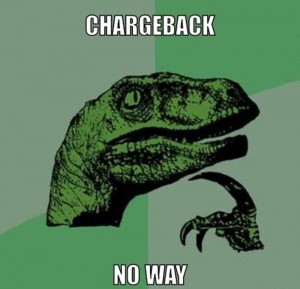
Sometimes everything starts with a misunderstanding between a seller and a buyer, as the result there appears a conflict over a transaction. And in order to solve it a buyer turns to his issuing bank filing papers to initiate a claim. Basically this is how a chargeback appears.

A chargeback is a forced return of a transaction to a buyer after it was completed. A reverse is available only to those who use their credit or debit cards for purchasing goods and services. And it is always advised as a last resort that a buyer can turn to if a communication with a seller is failed.
However, a chargeback can also be confused with such a concept as a refund, meanwhile these are two completely different terms. A refund is an agreed and simple return of funds from a merchant to a consumer. In other words this is a settlement directly between a seller and a buyer without an issuing bank being involved.
There also exist various reasons for a chargeback starting from “significantly not as described” and ending with fraudulent activities when a speculator take possession of one’s credit or debit card information. However, if we turn to statistics chargebacks on fraudulent activities prevail over other reasons for it.
The procedure of filing a chargeback consists of submitting standard forms and adding a free-form application that describes a point of view of a sender. Following the confirmation of acceptance there is also a 45 days period for adding relevant information concerning the case. Still one should not misuse chargebacks as it can lead to a cancellation of one’s debit or credit cards and even a prohibition may be imposed on getting new ones.
Except from the latter an obvious reason for filing a chargeback can be in complete dissatisfaction with a product or a service. As the result we approach the responsibilities of a seller that have to be met in order to avoid reverses. Leaving out fraud-related chargebacks, it may also appear over an accurate description of a commodity, so when a buyer gets a product there is a discrepancy between an expected item and a received one. So one of the very first precaution measures is a clear and transparent description of goods and services and if a commodity is tangible, a photo of an item would be also appreciated.
Dissatisfaction has already been mentioned as a reason for a chargeback, it does not mean that it can not be dealt with though. A customer would feel more secure if there is contact information of a seller on his web-site, for example, so a client can get in touch a merchant in order to solve a problem. Additionally, clear and transparent refund policy would serve as safeguard for both sides.
In case the deal has come to a chargeback it is crucial for both parties to remember that they should keep all the information concerning the transaction in question: an order confirmation, all correspondence with an opposite party, receipt for the payment, tracking information if a commodity is tangible – in order to present it to a payment processor that is going to hand it over to an issuing bank. It is also important to point out that there is no excessive information in terms of a chargeback.
Each credit card company has its peculiarities concerning processing chargebacks, however the common rule is that a customer has a legitimate right to turn to an issuing bank within a 120 days period (for U.S. transactions) and a 180 days period (for international transactions) in order to express his concerns over the transaction. And example is American Express credit card company does not allow to challenge chargebacks in case of an online business, so the only option to deal with an opposite party is through collector services and local police.
It is also known that in order to challenge a fraud-related chargeback, a merchant needs to contact his client and ask him to fill in the form stating that he processed the transaction personally. Meanwhile a whole procedure of filing a chargeback starts with a similar form claiming that a card owner did not provide the payment. Yet this form might be helpful in case a buyer did not recognise a transaction before filing a reverse.
Chargeback is quite an unwanted process from the side of a seller and a last option against an improper seller. Although it can be avoided if a seller is to follow a policy of transparency in terms of providing goods and services. Still if a reverse can not be evaded the best practise is to provide all the information concerning the case. In the end direct and honest communication with a client is always a fundamental way in solving any kinds of issues.





Quick Customer care response, accurate and broad assistance, easy to use client area.....





I am very happy with the service. I am with site valley for many years and at the present usimg 2 hosting packages. Their service is excellent and super fast. Thanks & Greatly Appreciated





I've been hosting my websites with Sitevalley for more than 6 years. Very satisfied with the services and reliability they provide, competitive prices, almost no downtime, fast and knowledgeable customer support.





I have been using side valley for a couple of years now and have to say I am very happy with the service they offer.I use many Hosting services but site valley stands out in front. Reliable service, great support.I don't normally leave reviews but felt I wanted to for this service as it has been fantastic





I didn't want to review so soon on into taking out hosting with site valley but I feel obliged because their customer service is outstanding, second to none, every time I had an issue it was sorted immediately. I would highly recommend Site Valley.





I have been with Sitevalley for over a year and it's the best hosting I have EVER used. And I have been through a lot of them.





The support staff are amazing, and it's clear that they have a passion for hosting websites. I've rather enjoyed this webhosting company and it's stability for the price is bar-none, amazing.





My collegue adviced me to use SiteValley as a reliable hosting provider with great prices, professional and fast Customer Service. My experience with SiteValley was exactly the way I was promised.





I have been with SiteValley for many years, and plan to stay with them for many more. Customer support is very responsive and knowledgeable.
SiteValley.com is rated 4.8 / 5 based on 329 Reviews »

© 2001 – 2026 SiteValley.com. All Rights Reserved.